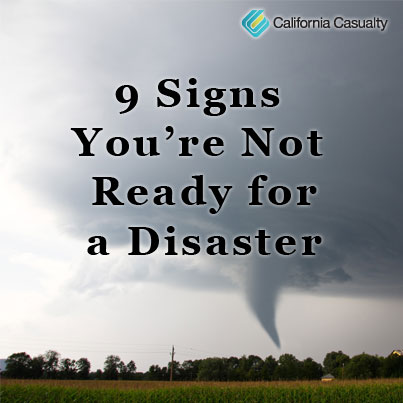by California Casualty | Homeowners Insurance Info |

Fall is my favorite time of year; the air turns crisp and cool, the leaves change brilliant colors and it’s a nice breather before winter sends its icy grip. As the days grow shorter and the leaves fall, it’s the perfect time to look around your home and get prepared for winter. Fall’s mild temperatures and adequate daylight provides an opportunity to check the heater, repair gutters and add extra insulation to the attic. An early autumn storm or blizzard is no time to learn you have leaks or other problems.
The Insurance Information Institute estimates that winter-related damage causes over a billion dollars in insurance losses annually. Prevent your home from being a statistic; use this checklist to make sure it’s ready for the onslaught of winter:
- Have your heating system checked and cleaned
- Inspect ceilings, windows and outer walls for cracks
- Change air filters
- Check your pipes and plumbing
- Inspect your roof for wear or damage and clean the gutters
- Install weather stripping and caulk around windows and doors
- Seal up foundation and driveway cracks
- Check your fireplace and chimney for cracks or leaks
Look around your deck or patio and yard; now is the time to clean and store seasonal outdoor furniture and flower pots, drain sprinkler systems, trim trees and shrubs, fertilize lawns and mulch gardens. Don’t forget to service the snow blower and lawn mower while you are at it.
You also need to make sure your home is fire safe and you check your smoke and carbon monoxide detectors; the National Fire Protection Association warns that home fires and carbon monoxide poisonings climb during the fall and winter months. They recommend:
- Installing smoke alarms in every bedroom, outside each separate sleeping area and on all levels of the home
- Installing carbon monoxide detectors in a central location outside each sleeping area and on all levels of the home
- Testing all smoke and carbon monoxide detectors and replacing the batteries once a year (fall is the preferred time)
- Having heating equipment and chimneys cleaned and inspected every year by a qualified professional
- Keeping any flammable material at least three feet from heat sources
- Checking fire extinguishers
- Knowing and practicing home escape routes
A vital preparation for any season is to review and understand your homeowners or renters insurance policy. Contact a California Casualty advisor today for a free, no hassle insurance policy review and comparison at 1.800.800.9410. You may also find you qualify for significant discounts and better coverage.
And, don’t forget your cars and trucks. For tips to make sure your vehicle is prepared for winter please visit https://mycalcas.com/2012/11/preparing-your-car-for-winter/.
Sources for this article:
https://www.resnet.us/library/preparing-your-home-for-fall/
https://www.nfpa.org/safety-information/safety-tip-sheets
https://www.iii.org/fact-statistic/winter-storms
https://www.naic.org/documents/consumer_guide_home_booklet.pdf
by California Casualty | Homeowners Insurance Info |

We all love the wonderful aroma of baking pies and roasting turkeys; however, preparing the Thanksgiving meal can be a dangerous time. The National Fire Protection Association is reminding everyone to be especially careful because Thanksgiving is the number one day for home cooking fires in the United States, followed by Christmas Day and Christmas Eve.
Unattended cooking was the leading factor in these fires, and cooking equipment was the leading cause of home fires that caused burns and injuries.
So as you begin preparing that mouth-watering meal for your friends and loved ones, here are some simple tips to keep everyone safe and the holiday meal a success:
- Always stay in the kitchen when you are cooking on the stovetop to keep an eye on the food
- Don’t leave home while cooking your turkey and check it frequently
- Remove any loose fitting clothing or dangling sleeves
- Make sure plastic bags, paper towels, oven mitts and other combustibles are away from open flames and heat sources
- Keep children at least three feet away from stoves
- Make sure kids stay away from hot food and liquids that can cause serious burns
- Keep floors clear and clean so you don’t slip or trip
- Keep knives out of the reach of children
- Never leave children alone with or in reach of candles, lighters or matches
- Have a fire extinguisher available
- Make sure that your smoke alarms are working properly
One of the more dangerous turkey cooking methods is deep fat frying; while it can provide a super succulent bird, fire agencies warn it can cause burns and eruptive fires. In fact, UL testing labs does not certify any home deep fat fryers. If you decide to use this method, the Butterball Turkey Hotline has very specific instructions to reduce the risk of fire or injury.
Also, on this holiday, don’t forget to thank our emergency personnel: firefighters, law enforcement officers and nurses who will be working, offering protection and comfort. California Casualty wishes everyone a very happy Thanksgiving. We are here to protect your auto and home from fire and other dangers with insurance specifically tailored for law enforcement officers, firefighters, nurses and educators. Learn more at www.calcas.com or call one of our advisors at 1.800.800.9410.
Sources for this article:
https://www.nfpa.org/safety-information/for-consumers/seasonal/thanksgiving-safety
https://www.redcross.org/news/article/Cooking-Safety-Tips-for-Thanksgiving-Chefs
https://www.butterball.com/how-tos/deep-fry-a-turkey
https://www.nachi.org/deep-fryer-inspection.htm
https://www.youtube.com/watch?v=yObDuYTfudY
by California Casualty | Homeowners Insurance Info |

by: Mark Goldberg
As more and more of us opt to rent rather than own a home, the monthly cost has been climbing. My wife and I are experiencing it as we start looking for a place for our daughter when she moves out of the dorm next year. There’s nothing worse than thinking you have found the perfect place and then realizing you really can’t afford it. Here are some things to take into consideration for your calculations.
First, how much rent can you really afford? Let’s face it; it’s really expensive these days to rent a place. A new Harvard study found many of us are now paying 50 percent of our income on rent. However, The U.S. Census Bureau and many financial experts say we should only pay 20 to 30 percent of our monthly take home pay. So, if you bring home $4,000 a month, you should consider monthly rents around $1,200. Every dollar more means less you will have for going out to dinners, concerts or saving for a home.
Second, calculate the expense of finding that place. Many first time renters fail to consider application fees many landlords now charge, the security deposit (often a month’s rent) and having to come up with first and last month’s rent. This can add up to a many thousands of dollars before you even get the chance to move into your new apartment or house.
Third, don’t forget to use your “scam radar.” As apartment and home rentals become scarce and more expensive, scammers are working to lure desperate people. The Federal Trade Commission is warning about a growing proliferation of criminals running fake rental ads or hijacking landlord advertising accounts trying to steal money from vulnerable consumers. Many people fail to confirm what they are renting and who they might be renting from, as evidenced by a New York bar owner who ran a fake ad about a one bedroom for rent that turned out to be his public restroom. He was shocked at the number of people who responded. With that in mind, here are the top signs that apartment or home rental ad could be fake:
- It seems too good to be true
- There is no address
- The contact is only by email or mail
- The landlord seems too eager to rent and doesn’t ask for your employment verification or any other tenant screening
- You are asked to wire money to apply or hold the apartment (especially if you never met anyone in person)
- You’re told you don’t need a lease or rental agreement
- The “landlord” says she is out of town and will only come back to meet you if you send money first
Finally, think about your other expenses. After you pay rent, will you have enough for utilities, cell phone, cable, internet, food, fuel, car payment and fun? Don’t forget about any student loans you have to repay. If you overdo what you pay for rent you may not have enough money for your other financial obligations, not to mention not being able to afford going out to see a movie or joining friends for dinner. Use this rent affordability calculator to gage what your budget allows.
Here are ways to reduce your monthly costs:
- Look outside the urban area like a nearby town or suburb for rentals
- Get a roommate or roommates
- Apply for rental subsidies offered by some cities and the federal government
- Scale down your expectations and find a smaller apartment
- Negotiate with the landlord
- Do without cable or satellite TV
- Have more meals at home with friends rather than going to restaurants
One expense you should never skimp on is renters insurance. Your landlord’s insurance doesn’t cover your things, and many landlords now require you to have our own policy. For as little as $15 a month you can protect your possessions from fire, theft or damage from a broken water pipe. Renters insurance also covers you in case someone gets hurt at your place and sues. Make sure you have the coverage you need, contact a California Casualty advisor for a quote today at 1.800.800.9410 or visit www.calcas.com.
Sources for this article:
https://www.census.gov/housing/census/publications/who-can-afford.pdf
https://www.jchs.harvard.edu/us-rental-housing-crisis-projected-grow-households-paying-more-50-percent-income-rent-topping-13
https://www.dailyfinance.com/2015/06/29/save-money-renting-apartment/
https://www.moneycrashers.com/how-to-find-cheap-apartments-for-rent-guide/
https://blog.credit.com/2015/06/how-much-rent-can-i-afford-119742/
https://mmink.com/calcs/renter1.html
https://www.moneycrashers.com/monthly-rent-afford-calculator/
https://www.gobankingrates.com/personal-finance/surprise-savings-account-wont-cover-cost-renting-apartment/
https://apartments.about.com/od/apartmenthunting/a/How-To-Recognize-And-Avoid-Apartment-Rental-Scams.htm
https://www.consumer.ftc.gov/articles/0079-rental-listing-scams
https://www.amny.com/real-estate/nyc-bathroom-advertised-as-hip-artist-loft-shows-how-desperate-people-are-to-live-in-city-1.10952017
https://portal.hud.gov/hudportal/HUD?src=/topics/rental_assistance
by California Casualty | Homeowners Insurance Info |

If you live in a flood prone area, you should have flood insurance. It seems like common sense but many of us still don’t get it. As rivers crested to new heights and raging waters destroyed homes in Central and Southern Texas this spring, the Insurance Council of Texas fears that less than half of those with damage purchased a flood policy. Many thousands affected by record flooding in South Carolina may also be without flood insurance; state insurance companies estimate that only 10% of residents purchased flood protection.
Here are some reasons why people don’t buy flood insurance:
- They think their homeowners or renters insurance covers flooding
- They think the government will help them
- They think it’s too expensive
- They didn’t know it was available
Floods are the number one disaster in the United States and the National Flood Insurance Program estimates that just three inches of water in a 2,000 square foot house will result in $23,000 in damage.
With that in mind, let’s soak up seven myths that might be floating around about flood insurance.
- Flooding is covered under most homeowners insurance.
It is not. Homeowners and renters need to purchase separate flood insurance protection. Umbrella insurance does not usually cover flooding.
- I don’t live in a flood prone area so I don’t need it.
Every state in the union has experienced flooding and it can happen anywhere. The National Flood Insurance Program estimates that 25 percent of flood claims come from areas outside of high-risk flood zones.
- The Federal Government will help pay for flood damage.
Federal disaster assistance is only available when the president formally declares a disaster. The aid comes as low interest loans, not compensation for your damage.
- Flood insurance is only for homeowners and businesses.
Flood insurance is available to renters. It is also available to condo owners and renters. It will cover damage to your possessions from a flood.
- Flood Insurance is expensive.
The average policy costs about $700 per year: the higher your risk, the higher your premium. Keep in mind the average residential flood claim amounted to more than $38,000.
- I can get flood insurance coverage immediately.
In most cases there is a 30 day waiting period from the date you purchase the insurance before it goes into effect.
- I can shop around for the best flood insurance deal.
While you can purchase flood insurance from numerous companies, the price is set by the federal government and doesn’t vary. Rates do vary depending on your flood risk and the year and type of construction.
If you have experienced flood damage, here are some things you should be doing:
- Make sure the building is safe to enter – mud and water may contain dangerous chemicals, bacteria or poisonous snakes and there could be a risk from electrocution
- Secure the property from further damage or theft with plywood, tarps or plastic
- Remove branches and other debris
- Before cleanup, take photos or videos of all the damage
- Throw out water damaged food including canned goods
- Keep receipts for any items you buy to make temporary repairs and for living expenses, they may be covered if your loss is insured or can be used for tax purposes if the loss is not covered
- Contact your insurance company – flooding and other water damage to your vehicle is covered if you have comprehensive auto insurance
For more information about what is and is not covered with flood insurance, visit https://www.floodsmart.gov/floodsmart/pages/residential_coverage/whats_covered.jsp.
California Casualty can help keep you above water with flood insurance. Find out more today at 877.652.2638 or visit www.calcas.com/flood-insurance. Make sure your property is fully protected from wind, fire, lightning, hail or falling trees with a policy review by calling an advisor today at 1.800.800.9410 or visiting www.calcas.com.
Resources for this article:
https://www.floodsmart.gov.
https://www.ready.gov/floods
https://www.thestate.com/news/local/article37740939.html
by California Casualty | Homeowners Insurance Info |

Why should I worry, there’s never been a disaster or emergency in my area before? If that’s your reaction to emergency preparation, you’re setting your family up for disaster. Here are nine other signs you probably aren’t ready for the unexpected:
- You have no property insurance or the “bare minimum” because your house is paid off.
- You couldn’t be bothered signing up for those annoying cell phone emergency alerts.
- What’s a weather alert radio?
- You only know one way in and out of your neighborhood.
- When someone mentions geographic land features, you think they are talking about the mound left in the front yard where the tree was removed last year.
- When you hear there is a tornado or severe thunderstorm watch, you actually go out to watch for them.
- You think a bottle of water and a fanny pack are all you need if you are evacuated.
- Having a home inventory means knowing how much toilet paper and milk you have.
- Heck, we’ve been waiting for that big storm so we can get a new roof (we already have five leaks, what’s one more).
Seriously, disaster preparation is not a laughing matter; just ask anyone who survived the fury of Hurricane Sandy, the horrors after Hurricane Katrina, or dug through the ashes of their homes in the recent disastrous West Coast fires. September is National Preparedness Month when emergency experts are asking everyone to know their risks, develop a plan, prepare an emergency supply kit and make a home inventory. In the next few days and weeks we’ll share details on things you need to do before a disaster strikes. In the meantime, visit www.ready.gov for more information on preparing for an emergency, before it’s too late.
by California Casualty | Auto Insurance Info, Homeowners Insurance Info |

Odds are you know someone who is getting married this summer. Now through September is when the majority of weddings take place each year in the U.S. While it’s a time of joy and dreams of the future, there are many important decisions: how many people to invite, is there a need for a wedding planner, who will cater the meal and what about entertainment. Once the rings are exchanged and the honeymoon is over, there’s another important step – getting your auto and home insurance in order. Here’s a checklist for newlyweds.
- Combine Your Insurance
If you both have separate cars with different insurance companies, now that you are married you can find discounts by putting both vehicles on the same policy. It will also ensure that both drivers are covered no matter which car they use. Get extra savings by bundling your autos with your home or renters insurance.
- Marriage Discount
Make sure to inform your insurance company that you got married – most auto and home insurance companies offer important discounts for newlyweds. Men under the age of 25 are usually considered high risk drivers. However, once they marry they often see a big drop in insurance premiums. The lower rates can also apply to those in domestic partnerships.
- Increase Homeowner or Renters Coverage
Wedding presents are wonderful. You now have a new set of china, expensive new appliances and other things for your home. These assets need to be covered. Talk to an insurance advisor to make sure you have enough coverage to protect all the things you own and to increase your liability protection. It’s also a great time to create an inventory of all the things you own to help you purchase the right insurance protection and make filing a claim much easier.
- Get Extra Protection for High Value Items
That beautiful new wedding ring and special gifts like fine art or silverware may need scheduled personal property protection, often called a “floater,” to make sure they are covered for their full value. Most homeowners and renters policies will provide limited coverage for those items. Scheduled personal property coverage will also pay to replace a ring, without a deductible, even if it was misplaced or damaged in the disposal.
Just like marriage, California Casualty is a committed partner in helping with your auto and home insurance needs. Don’t go it alone, contact a California Casualty advisor today for a free quote or no hassle policy review at 1.800.800.9410 or visit www.calcas.com.
Resources for this article:
https://www.knowyourstuff.org






